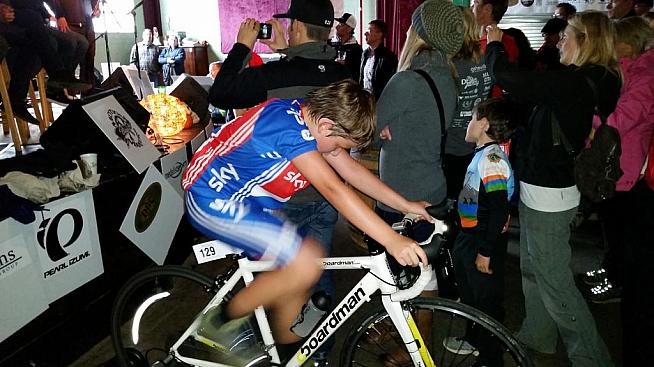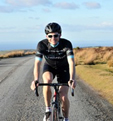Having just completed my monthly set of fitness tests, I am pleased to say that the training that I started at the beginning of November is slowly starting to translate into quantifiable results. Short term power is up 12% and 5 minute aerobic capacity is up just over 4%. My efficiency at aerobic threshold is up 10% meaning that I am delivering more power for the same cardiovascular cost - who says base endurance training is dead! I still have the dreaded 20 minute lactate threshold test on Sunday, but by then the pain from my post NYE hangover might make it seem not quite as tough.
If you are interested in measuring the effectiveness of your training there are three simple tests that you can do at home. What you need is the following:
- A bike on a turbo trainer (this gives a consistent environment for comparable results)
- A heart rate monitor
- A speed sensor or power meter
Aerobic Threshold Test
This first test is the easiest and least stressful to complete and can be done weekly. It is a test of metabolic aerobic fitness and is really useful for deciding when you have completed enough base endurance training. What we are going to compare is output with input - how much speed or power can you generate for a given effort or heart rate.
Warm up: 10-15 minutes and gradually raise your heart rate to the middle of Endurance Zone 2.
Drill: hit the lap button on your computer and ride for 40 minutes keeping your heart rate in the middle of Zone 2. Record power or speed and hit the lap button at the end so that you can isolate the results.
Cool down: 10 minutes easy
When you have downloaded your data do the following basic maths to work out your Efficiency Factor (EF).
If you have a power meter divide your average power by your average heart rate for the 40 minute effort. For example 220w/140bpm = EF 1.57
If you have a speed sensor multiply your average 40 min speed in km/h by 1000 (mtrs in km) then divide by 60 (mins in hour). Next divide that result by your average 40 min heart rate. For example 31km/h *1000 = 31000/60 = 516/140bpm = EF 3.69.
If you conduct this test regularly you should see the trend in your EF rise over time. If the next time you can generate 230w at 140bpm then your EF will have risen to 1.64. If your speed has increased to 35km/h then your EF has improved to 4.16 Once your EF at aerobic threshold has stabilised and you have not seen any improvement in a couple of weeks this is a sign that you have done enough base endurance training.

Aerobic Capacity Test
Speed or power at aerobic capacity can be sustained for around 5 minutes. This test is an all out 5 minute time trial and is best done after a rest or light recovery day. This is a more stressful test as you are going full pace so I would recommend doing it every 3-4 weeks. What we are measuring here is how much power you can generate or how fast can you go whilst your body is processing its maximum amount of oxygen.
Warm up: 10-15 minutes gradually raising the intensity to Tempo pace or Z3
Drill: hit the lap button on your computer and ride for 5 minutes in an all out time trial. Try and empty the tank out in the last minute and hit the lap button at the end so that you can isolate the results.
Cool down: 10 minutes easy
When you have downloaded your data look at the average power or speed for the 5 minute effort. This again should increase over time until the end of the build phase in your training. Aerobic Capacity is one key determinant of cycling performance.
Lactate Threshold Test
Lactate Threshold is the key determinant of cycling performance in endurance events and as such is the key test. This is the most stressful of the three tests and should definitely be done when rested.
Warm up: 10 minutes incorporating 3 bursts of 20 seconds high cadence. After 10 minutes kick into a high gear and deliver a hard 30 second effort at high cadence followed by 2 minutes cruising - repeat 3 times.
Drill: hit the lap button on your computer and ride for 20 minutes in an all out time trial. Start conservatively holding a consistent pace for the first 15 minutes. With 5 minutes to go try and increase the intensity, with 3 minutes to go try and empty out the tank and go flat out. Hit the lap button at the end so that you can isolate the results.
Cool down: 10 minutes easy
When you have downloaded your data look at the average power or speed for the 20 minute effort. This again should increase over time until the end of the build phase in your training.
Conclusion
So there you have it. Three simple 'do at home' tests that measure your fitness across the three energy systems. There is a general misconception that you can't really test fitness unless you go to a lab and pay for a set of expensive tests. I like going to a lab once a year to test in a more scientific way, but that has more to do with feeling just a little bit 'pro' for an hour strapped up to a gas analyser! However most of my testing is done as above at home on my turbo trainer. I now have a lot of data to draw conclusions from and can adjust my training accordingly.
If you are interested in doing any supervised tests with me then get in touch and we can do this in the turbo studio at Carb Cycles Barnstaple.
Rob Wakefield is a fully qualified Level 3 Cycling Coach with the Association of British Cycling Coaches and founder of Propello, a cycling focused health and fitness business delivering Performance Training Programmes and Bespoke Coaching to cyclists anywhere in the world.
All cyclists who are looking to improve their speed, endurance or strength will benefit from a structured training programme. Propello Training will improve how your muscles, lungs and heart work and will enable your body to transport and utilise fuel effectively - making you faster and stronger for longer.
Click here to learn more about Propello.
0 Comments





